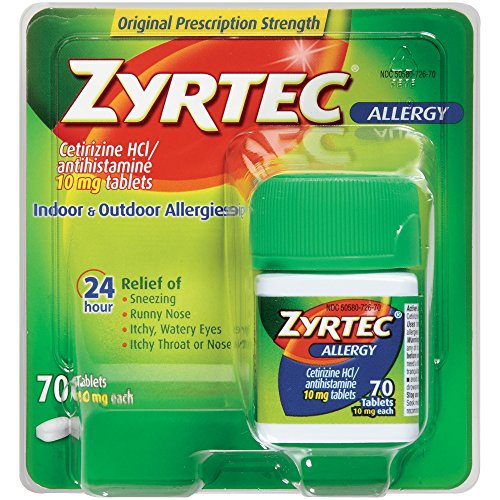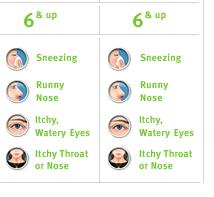ZYRTEC Allergy Tablets provide 24-hour prescription-strength relief of your worst allergy symptoms of sneezing, runny nose, itchy, watery eyes, and itching of the nose and throat. ZYRTEC is the #1 allergist recommended brand (among OTC oral antihistamines).
Relieve Your Allergies |
| Temporarily relieves these symptoms due to hay fever or other upper-respiratory allergies: |  |  |
| How the ZYRTEC Family of Products Work
From sneezing, runny nose, itchy throat to itchy eyes, allergy sufferers are intimately familiar with their symptoms. But what you might not know is exactly how the ZYRTEC family of allergy medicines work and how they can help relieve those symptoms. So here's a short overview for handy referral and reference.First Things First. Just What's an Allergy Anyway?
An allergy is a hypersensitivity disorder of the immune system brought on by environmental substances known as allergens. Your immune system detects something in the air which is usually harmless to most people. And then it fights back in a way that allergy sufferers know all too well. Depending on the season, it might be tree pollen (one of the worst allergy offenders, which can arrive early in the season and travel for miles); grass pollen (most common in spring to early summer); weed pollen (weeds are the worst producers of pollen, from late summer through fall), or spores from fungi or mold. Year-round, it can be dust mites (chances are they are all over your house, especially in bedding and upholstered furniture), cockroaches, pet dander (both cats and dogs), or spores from indoor/outdoor fungi or mold. Your immune system produces antibodies to defend against these allergens. When antibodies respond to an allergen, they bind to the cells in a process that produces histamine. Histamine causes your system to react, producing inflammation and allergy symptoms, including irritation inside your nose. You sneeze. Sound familiar? Here's Where the #1 Allergist Recommended Brand* ZYRTEC Comes In
Antihistamines work by blocking the action of the chemical histamine to relieve sneezing, itchy, watery eyes, runny nose, and itchy nose and throat. Antihistamines come in different forms, and are available over the counter and by prescription. When you are considering the appropriate way for you to develop an allergy relief strategy, you may want to talk to your doctor. An ongoing conversation with a health care professional can ensure your personal strategy improves as you learn about what causes triggers and why. *Among OTC oral antihistamines |
|
| Identifying Allergies What causes an allergic reaction? What are your allergy triggers? Whether pollen makes you sneeze or cats make your eyes water, understanding your allergies is the first step toward living with them.
|
Indoor Allergies
So, what are people allergic to? Though everyone's allergies are unique, here is the list of usual suspects. |
| | Mold & Mildew Allergies |  | Mold
As you probably already know, molds are something you should stay away from. Inhaling or touching them can cause immediate or delayed symptoms, including sneezing and runny nose. Exposure to mold can even affect non-allergic people, irritating the eyes, skin, nose, throat, and lungs.Mold reproduces through tiny airborne spores. When they land on a wet surface, mold can start to grow indoors. Since mold needs moisture to survive, the trick is to keep your home dry. | | Manage Your Mold Allergies
Mold can be sneaky, growing just out of sight and causing a slew of allergy symptoms. Kill it and help keep it from coming back with these steps: | - Fix leaky faucets and pipes
- Make sure all rooms are properly ventilated
- Use a vented exhaust fan to remove excess moisture
- Keep the humidity in your house below 50% with air conditioners and dehumidifiers
- Install extra dehumidifiers in places where mold collects
- Use cleaning solutions designed to kill mold and mildew
- Don't over-water indoor plants - wet soil encourages mold
|
| | Pet Dander Allergies |  | Pet Allergies
Animal allergies are very common; however, many people don't know what triggers the allergy. Most think it's the fur. The major culprit is the saliva that sticks to the fur when your pet cleans itself. The saliva contains a protein that causes a reaction. Cats can be worse than dogs because they lick themselves more often, and spend more time in the house.Allergy-causing proteins can also come from your pet's urine. This explains why some people are allergic to guinea pigs, gerbils and other rodents. A pet allergy can take more than 2 years to develop, and may not show signs of improvement until 6 months after the animal stops living with you. Pet allergens can remain in carpet and furniture for 4 to 6 weeks, and can linger in the air for months. So before you move into a new house or apartment, find out if a pet has been living there. | | Manage Your Pet Allergies
Pets bring a lot of love into your home. They can also trigger your allergies. Here are a few ways to help reduce pet dander: | - Keep pets off upholstered furniture and carpets, and out of the bedroom
- Bathe pets frequently to wash away trigger proteins, dander, and pollens that may cling to their fur
- Brush pets outside
- Ask someone without allergies to handle grooming and litter box chores
- Choose low-pile carpets and steam clean them regularly
- Wear a dust mask to vacuum
- Use a high-efficiency particulate air (HEPA) filter for vacuuming and air filtration
|
| | Dust Mites Allergies |  | Dust Mites
Even though you can't see them, depending on where you live in the US, chances are dust mites are all over your house. They thrive in bedding, upholstered furniture, and carpets. These tiny creatures are perhaps the most common cause of perennial allergies and can trigger symptoms similar to pollen allergy. In fact, it's the proteins in the dust mite droppings that cause the allergic reaction. Tidy up each week by vacuuming and dusting with a damp cloth. | | Manage Your Dust Mites Allergies
A home that feels like a haven away from allergies can be a huge relief. Use these tips to help reduce dust and dust mites, a common trigger. | - Straighten up your house and dust with a damp cloth each week
- Use a high-efficiency particulate air (HEPA) filter for vacuuming and air filtration
- Use synthetic mattress pads and pillows
- Use zippered dust-proof covers on mattresses and pillows
- Wash sheets and blankets in hot water each week
- Avoid wool and feather-filled comforters
- Avoid upholstered furniture and blinds. Minimize carpeting if possible
- Choose washable curtains, rugs, and blankets
|
|
|
Outdoor Allergies
So, what are people allergic to? Though everyone's allergies are unique, here is the list of usual suspects. |
| | Hay Fever Allergies |  | Hay Fever
Hay fever is a catchall term generally used to refer to seasonal allergies such as grass, weed, and tree pollens. | | Manage Your Hay Fever Allergies
When people talk about hay fever, they're really referring to the symptoms of grass, tree, and weed pollen allergies. If any of these pollens are triggering your symptoms, these tips may help: | | | | - Try not to go out between 10 AM and 4 PM, when pollen is at its worst
- Cover up with a hat, gloves, glasses, paper mask, and long-sleeve t-shirt to minimize pollen contact
- Shower after being outdoors
- Keep your house and car windows closed
- Plan a low-pollen getaway, such as a trip to the beach
- Replace pollinating grasses in your yard with allergen-free features like rocks, sand, and water
- Limit outdoor activities on high-pollen days
- Don't hang clothing or linens outdoors to dry
- Vacuum and dust with a damp cloth weekly
- Install HEPA pollen filters at home and in your car
|
| | Grass Pollen Allergies |  | Grass Pollen
Although more than 1,000 species of grass grow in North America, only a few produce highly allergenic pollen. That's small comfort if you're one of the millions of people affected by grass pollen. The most common grasses that can cause allergies are Bermuda grass, Johnson grass, Kentucky bluegrass, Orchard grass, Sweet vernal grass, and Timothy grass. Grass pollen is most common in spring to early summer. | | Manage Your Grass Pollen Allergies
If summer is the worst time of year for your allergies, grass pollen could be to blame. Here are a few extra strategies to help you cope: | - Learn to recognize common grass triggers: Timothy, Bermuda, orchard, red top, and blue grasses
- Wear a mask to mow the lawn, or ask someone without allergies to help
- Keep grass in your yard short
- Consider replacing your grass lawn with low pollen alternatives - Irish moss, bunch, or dichondra
|
|
|
What's In the Box
ZYRTEC Allergy (10 mg), 70 Tablets. | PRODUCTS |
Browse the products below to find the ZYRTEC product that is right for your symptoms.
|
Trademark Information:
ZYRTEC®
YOUR ZNA™ |
|


















